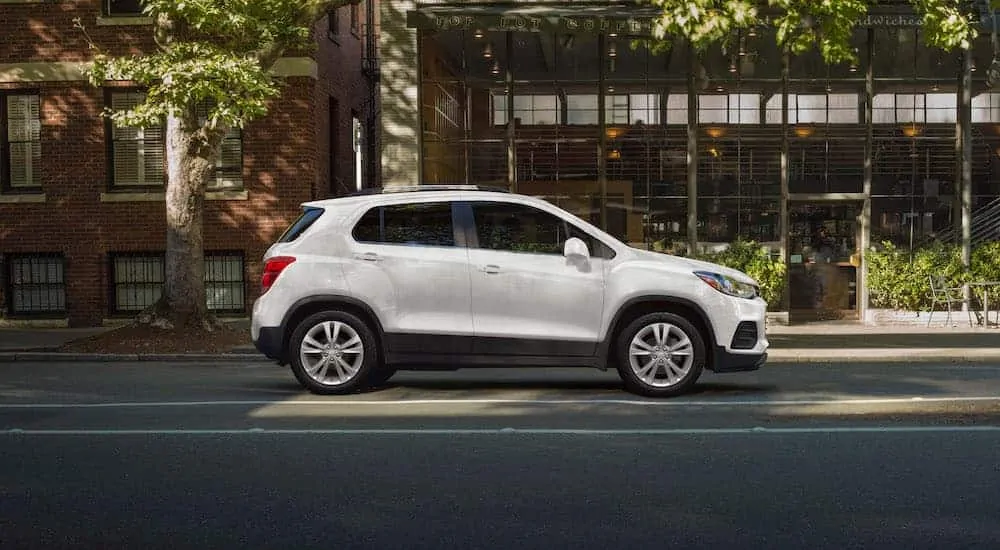The Chevy Trax and the Honda HR-V are living relatively parallel paths in the subcompact SUV class. The Trax appeared on the US market in 2015, while the HR-V was introduced in 2016, and the 2020 models demonstrate a lot of growth within the first generation. For those in the market for a subcompact or crossover SUV, it may be easy to narrow down the choices to the 2020 Chevy Trax vs 2020 Honda HR-V, but how to decide between the two?
Both are sporty and good looking vehicles that feature plenty of room for passengers and cargo. Each vehicle is generous with fuel economy. But choosing which vehicle should take the privileged place within your garage can be a stressful process. Sorting through all of the facts and the opinions posted on the internet about each option can be confusing, but taking your decision one step at a time can relieve some of the stress of making the “right” decision. Both vehicles have received high accolades amongst the vehicles in the class, which is certainly promising for anyone who might be overwhelmed by this increasingly popular segment of automobiles. However, looking at each option side-by-side should help narrow down the features and options that will work best for your family.
What the People Are Saying
Early reviews are flattering for both vehicles; however, the 2020 Trax and 2020 HR-V each have their own strong points. Chevy’s contribution to the subcompact SUV segment, the Trax, receives unanimous praise for its abundant passenger room. Though the Trax has a bit less cargo room than the HR-V, with 18.7 cubic feet or 48.4 cubic feet with the rear seat folded, it offers more storage spots, including a front passenger seat drawer in the LT trim and above.
Chevy vehicles come equipped with Apple CarPlay and Android Auto compatibility, with an intuitive infotainment system that has been praised across the manufacturer’s line up. As a result, Trax receives numerous thumbs up for being fun to drive as well as friendly for a variety of drivers, including city drivers, family haulers, and those who need regular room for cargo.
Trax also offers the Redline Edition cosmetic package that adds an extra level of “cool” to the appearance of the vehicle. Available on the LT trim, this package adds black body accents, and black and red 18-inch alloy wheels. This takes the place of the now-discontinued Midnight Edition.
The 2020 Honda HR-V is also applauded for its roomy interior, with plenty of room for five passengers. Its cargo space is also amongst the highest in the segment, at 23.2 cubic feet with all seats upright, or 55.9 cubic feet with the rear seats folded. It lacks the small storage space of Trax, however, with limited space in the center console and doors.
The fun factor is adequate in the Honda HR-V, with Android Auto and Apple CarPlay compatibility for Sport trim and above, and Bluetooth streaming for all trims. Interestingly enough, the only packages offered on the HR-V are for splash guards, a cargo tray, wheel locks, and all-season floor mats above the standard––yet robust––trim offerings. For those who don’t wish to be concerned with options above and beyond the standard features, this is a huge benefit. For those who rely on option packages to customize a vehicle to specifications, this might be a serious drawback.
Features Under the Hood
Another area in which the 2020 Chevy Trax and 2020 Honda HR-V are similar is under the hood.
The Trax is powered by a 1.4L inline-4 engine that offers 138 horsepower and 148 lb-ft of torque. This engine is paired with a six-speed transmission, and while Trax is a front-wheel drive vehicle, drivers can choose optional all-wheel drive models, which feature disc brakes on all four wheels. The front-wheel drive models have a fuel economy of 26 mpg in the city and 31 mpg on the highway, while AWD models get 24 mpg in the city and 29 mpg on the highway.
The Honda, on the other hand, features a 1.8L inline-4 engine that supplies 141 horsepower and 127 lb-ft of torque. This engine is paired to an automatic continuously variable transmission, and all-wheel drive capability is available on all models, regardless of trim. Front-wheel drive HR-Vs have a fuel economy of 28 mpg in the city and 34 mpg on the highway, while AWD models manage 27 mpg in the city and 31 mpg on the highway, topping the fuel economy of the 2020 Trax.
Choosing the Trim for Your Needs
Both Chevrolet and Honda considered their 2020 subcompact SUV offerings with a variety of drivers in mind. From simply-equipped base models to luxurious top-of-the-line options, each manufacturer offers plenty of safety, technology, and comfort features to attract a variety of drivers and accommodate nearly every commuter’s style.
The 2020 Chevy Trax is available in three trim levels, each of which is well-equipped. The base LS model includes handy features such as automatic headlights, side mirrors that can be manually folded, power-adjustable lumbar support for the driver, OnStar with 4G LTE WiFi hotspot, 7-inch touchscreen infotainment system, two USB ports, and a 60/40 split-folding rear seat. Drivers can add tinted windows and cruise control to the LS with the “Tint and Cruise” package.
The LT trim adds roof rails, remote start, heated mirrors, satellite radio, 110V three-prong outlet, and a cargo cover. The optional “Convenience” package adds premium seats with leather inserts to the LT, as well as a leather-padded steering wheel, keyless entry and ignition, and power-adjustable driver’s seat. The “Driver Confidence” package adds safety features to the LT, including blind-spot monitoring, rear traffic alert, and rear parking sensors. “Sun and Sound” adds a sunroof and a premium seven-speaker Bose audio system.
The Premium Trax trim gets 18-inch wheels, fog lights, faux leather seating, an auto-dimming mirror, a standard Bose audio system, and heated driver and front passenger seats. Forward collision alert and lane departure warning safety features are added, as well.
The 2020 Honda HR-V is available in five trims, but as mentioned, no optional entertainment or other major packages are offered.
The LX is the base model, but offers plenty of fun and quality, with 17-inch alloy wheels, Bluetooth streaming audio, 5-inch radio display, LED daytime running lights, a rearview camera with multiple views, and a 60/40 split-fold rear seat.
The Sport trim adds roof rails and fog lights, as well as 18-inch wheels, Apple CarPlay and Android Auto compatibility, and a 7-inch infotainment display to coordinate entertainment and vehicle alerts.
Models in the EX trim and above come equipped with Honda Sensing, Honda’s full host of safety features. Honda Sensing includes Road Departure Mitigation, which adjusts steering and braking to prevent swerving between lanes or off the road unintentionally. It also includes Adaptive Cruise Control, Lane Keeping Assistance, Collision Mitigation Braking, and more.
EX models also include heated front seats and a power moonroof, as well as keyless entry and ignition, heated side mirrors, and automatic climate control. The EX-L trim gives HR-V leather seats and steering wheel. The Touring trim includes standard AWD, LED headlights, an eight-way power-adjustable driver’s seat, integrated satellite navigation, and the HomeLink remote system.
Our Conclusion
At first glance, the 2020 Chevy Trax and 2020 Honda HR-V are similar vehicles within the subcompact/crossover SUV market. For those who crave options and packages to personalize your driving experience, the Trax is the clear choice, as HR-V offers only standardized trims. On the other hand, Honda has provided the HR-V with a more powerful and more fuel-efficient engine, which can be extremely important to those with a budget in mind. Honda also offers a fully comprehensive safety feature package; however, it is only available in the EX trim or above, while Chevy offers a few safety features per trim, culminating in the Premier trim. While both vehicles are very comparable, the differences between the two encourage drivers to prioritize future usage and features before making a final decision.






